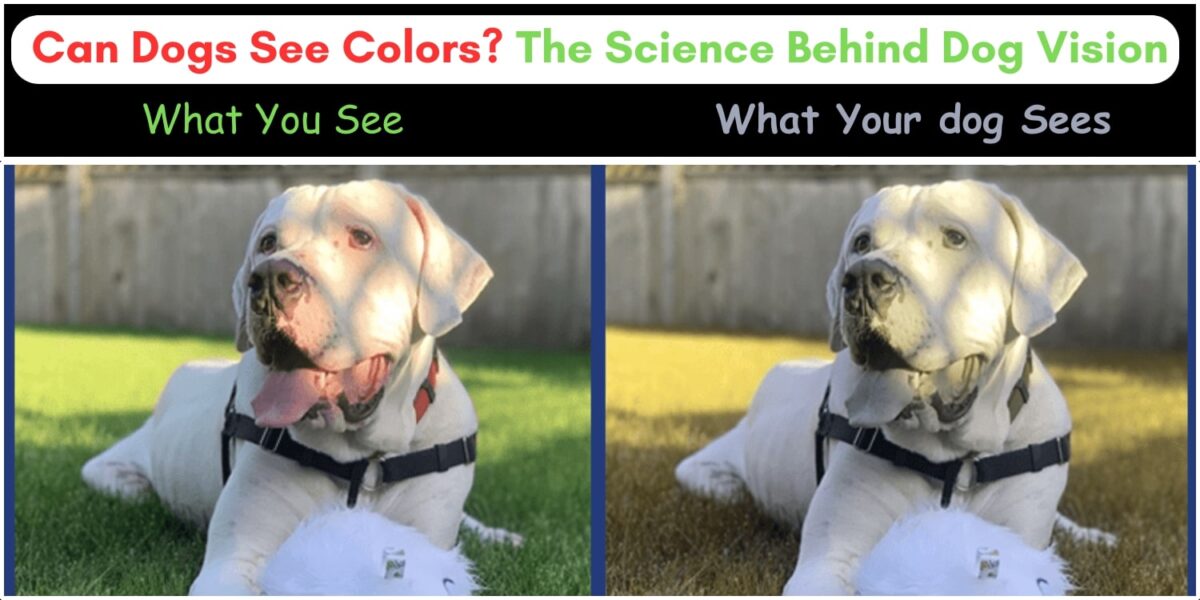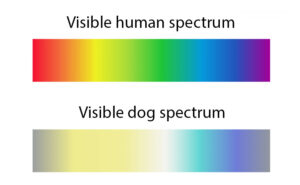Can Dogs See Colors? The Science Behind Dog Vision

When we think about how dogs experience the world, one of the most common myths is that they see only in black and white. But is that true? Can dogs see color? The short answer: Yes! But not the way humans do.
Dogs experience a limited color spectrum, which affects how they see their surroundings. Let’s dive into the science behind dog vision, what colors they can actually see, and how this impacts their daily lives.
Can Dogs See Color?
For many years, people believed that dogs could only see in shades of gray. However, scientific studies have debunked this myth. Dogs can see color, but their vision is different from ours.
Humans have a trichromatic color vision, meaning we have three types of cone cells in our eyes that detect red, green, and blue light. Dogs, on the other hand, have dichromatic vision, meaning they have only two types of cone cells. This limits the range of colors they can perceive.
So, what does this mean in practical terms? Dogs don’t see the world in black and white, but rather in shades of blue, yellow, and gray.
How Dog Vision Works (The Science Behind It)
To understand how dogs see colors, we need to look at how their eyes function.
Rods and Cones in Dog Eyes
The retina in the eye contains two types of photoreceptor cells:
- Rods – Help with night vision and detecting movement.
- Cones – Detect colors in bright light.

Humans have three types of cones, allowing us to see a wide spectrum of colors. Dogs, however, have only two types of cones, making their color perception more limited.
Why Dogs See Certain Colors Better
Since dogs have blue and yellow-sensitive cones, they perceive blue and yellow hues most vividly. This is why toys and training tools in shades of blue and yellow stand out to them.
If you’re shopping for dog supplies online, it’s a good idea to choose toys, training aids, and feeding bowls in colors that dogs can see best. Blue and yellow items can enhance engagement and training efficiency!
Why Dogs Struggle with Red & Green
Because dogs lack red-sensitive cones, they can’t distinguish between red and green. Instead, these colors appear as shades of brown or gray. So, a bright red ball on green grass may blend in, making it harder for a dog to find.
To keep your pup happy and engaged, consider buying dog care products that cater to their vision needs, such as blue or yellow chew toys, feeding mats, and training equipment.
What Colors Can Dogs See?
Dogs primarily see:
- Blue (and shades of blue)
- Yellow (and shades of yellow)
- Grayish tones instead of vibrant reds and greens
They cannot see colors like:
- Red – Appears as dark brown or black
- Green – Appears as dull yellow or gray
If you want to buy your dog high-quality pet care products, look for blue or yellow toys to ensure they stand out!
What Colors Do Dogs See Best?
Since blue and yellow are the most distinguishable colors for dogs, they see these shades most clearly. This is due to their dichromatic vision, which is most sensitive to shorter (blue) and medium (yellow) wavelengths of light.
Real-life example:
- A bright blue ball on green grass will stand out.
- A red ball on green grass may blend in, making it harder for the dog to locate.
- This is why many dog-friendly toys and agility training equipment are designed in blue and yellow!
If you’re training your dog or looking for dog supplements to support their eye health, choose products that include essential vitamins like A, C, and E—these help maintain good vision and overall health.
What Color Is Hardest for Dogs to See?
The hardest colors for dogs to distinguish are red and green. Without the red-sensitive cone, they perceive these colors as shades of brown, gray, or black.
What Colors Can Dogs Not See?
- Red appears as dark brown or black.
- Green blends into yellow or gray.
- Purple looks more like blue.
This means that if you’re playing fetch with a red toy in the grass, your dog might struggle to find it because both colors look similar to them.
How This Affects a Dog’s World
Knowing that dogs see blue and yellow best can help us make smarter choices when it comes to:
- Choosing dog toys – Pick blue and yellow toys for better visibility.
- Training & agility courses – Equipment in blue and yellow is easier for dogs to navigate.
- Safety considerations – Avoid relying on red or green signals when training your dog.
For example, if you’re training your dog with color-coded commands, a red sign may not stand out to them. Instead, using contrasting blue or yellow will be more effective.
To keep your dog in top health, consider adding dog supplements like omega-3 fatty acids and antioxidants to their diet—these nutrients support vision and cognitive function.
Fun Facts & Real-Life Applications
- Police & hunting dogs rely more on movement and scent rather than color to detect objects.
- Dogs have better night vision than humans because they have more rod cells in their eyes.
- Many dog agility courses use blue and yellow obstacles because they are the easiest for dogs to see.
Next time you’re picking out a new toy for your furry friend, remember—blue and yellow will make them happiest!
Also read this: Bringing a Stray Pet Home: Top Priorities for a Smooth Transition and Happy Pet
Conclusion
So, do dogs see color? Yes—but in a limited spectrum! While they can’t see the full range of colors that humans can, they can still see blues, yellows, and grays.
By understanding how your dog perceives colors, you can improve their playtime, training, and even safety. Try observing how your dog reacts to different colored toys—you might be surprised!











